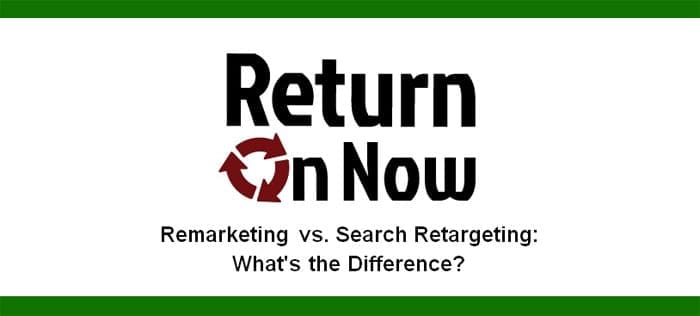One of the main service offerings we provide is Search Engine Marketing (SEM), a.k.a. Pay Per Click (PPC) Advertising. We typically opt to describe it as SEM rather than merely PPC, because it casts a much wider net.
There are several different ways to manage SEM, PPC, and online advertising as a whole.
One of the hot topics over the past few years has been remarketing.
If you ask 10 different internet marketing professionals what remarketing is, you could very well get back 10 different answers.
Probably close to half of them would struggle to not only define this term, but to differentiate it from the term “retargeting”.
Both of these concepts are important to understand.
Why? Because they provide techniques and tools that will help you convert previously lost leads or customers in the future.
And in some instances, you can get exponentially higher levels of brand exposure at little to no cost.
Once you understand the differences between the two, the benefits will become abundantly clear.
What is Search Retargeting?
Let’s start with the simpler of the two concepts – search retargeting.
For search retargeting, the objective is to re-engage with site visitors based on their behavior on prior visits.
This is most frequently managed using a banner ad on a 3rd party site.
First, start off by thinking about what a potential customer might do on your site to indicate that they are interested in a specific product or service.
Perhaps they might visit the category, product, or features pages.
Or maybe they add items to the shopping cart and then abandon it altogether.
Next, think about what messages would be appropriate for catching their attention again, in hopes of bringing them back to the website.
If they looked at your category for television sets, for example, you would want to approach them again with a message about similar or complementary products.
If they added an ebook about healthy eating to the cart and then left, you would then retarget with information about eating or preparing healthy meals. You get the picture.
To see this through, you then need to set up a targeting segment (to cookie them when they do whatever action you want to retarget), and use a major ad network to literally retarget them with banner ads.
These ads then show up on third party sites who serve up display ads via their own ad network, the same one with whom you signed up.
It’s pretty simple of a concept, and can result in sizable improvements in conversion or close rates.
Think of this as the closest way to do downfunnel marketing using display, because that’s pretty much what it is.
What is Remarketing?
Remarketing is a bigger universe of techniques.
It includes anything you do to target or personalize a message based on customer’s previous interest in your products or services. after interacting with them.
Think of the difference as similar to that of integrated marketing vs. shotgun marketing.
With the latter, tactics are planned, executed, and measured in isolation.
This can cause marketers to overlook the influence of one medium on the others.
With the former, everything is more aligned and measured in tandem.
While there is plenty of value in running a retargeting campaign in isolation, remarketing is much more strategic.
The other media that are most frequently used for remarketing include email and direct mail.
In both cases, you can mine your database to find people who have specific product interests based on browsing or search behavior, others who have filled up a cart and left, and even customers who actually bought a product.
For the closed customers, you can remarket from multiple angles, including:
- Remind them when refills or replacements are due.
- Pitch them on complementary products, such as ink refills for non-disposable pens.
- Remind them of products they removed from the cart before buying, especially if a related promotion is available.
- Try to sell them other products that “users of” tend to also buy. Amazon does a great job of “People who bought this also bought…”, which is exactly what I’m talking about here.
- Ask for referrals to friends and family who might also be interested, assuming their experience with your business was positive.
There are many more ways to drive value with remarketing.
With a little creativity, you will find that this can drive some excellent incremental business.
Conclusion
Remarketing and search retargeting are outstanding ways to squeeze a little more performance out of the prospects and customers who have visited your website.
Retargeting is a great first step for dipping your toe in on remarketing.
But over time, put in the effort to build out a more integrated strategic system for remarketing.
In the end, you will enjoy the benefits to your bottom line.
Tommy Landry
Latest posts by Tommy Landry (see all)
- B2B SEO in 2025: Winning Visibility in AI-Curated Buyer Journeys - December 16, 2025
- Local SEO Meets AEO and GEO: How AI Platforms Read Local Authority Signals - December 9, 2025
- What Is an SEO Proposal and What Should It Include? - December 2, 2025





